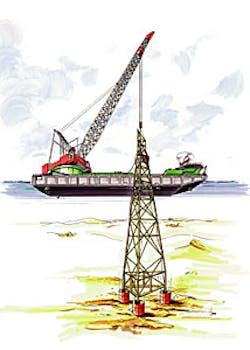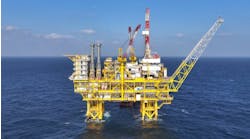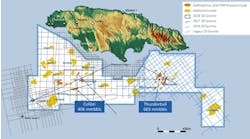Mark Riemers
Suction Pile Technology
The North Nemba Flare tower is shown being installed with suction pile technology. Chevron is the operator and McDermott-ETPM was the contractor.
A marginal field unmanned platform concept called the "self installing platform" (SIP) has been developed by Suction Pile Technology of Amsterdam (The Netherlands). The SIP can be towed to the field, and following ballasting to the seabed, the platform foundation is set up using suction piles.
The great advantage of the SIP concept is that heavy lift barges are not required for installation offshore, which makes it very attractive for remote areas. Nevertheless, the SIP concept is also competitive with the traditional platforms being installed by the heavy lift barges.
Furthermore, as no impact pile driving is required, the handling of heavy, costly, and sensitive pile driving hammers is avoided. The SIP is suitable for water depths ranging from 30 ft up to 350 ft and is installed using standard seagoing tugs and a 4-point moored DSV or a small work barge. Topside weights can be accommodated from 50 tons up to 500 tons or even more.
The SIP concept consists of a mono-pile of varying diameter (depending on the number of slots - from one to six) supporting the topsides deck, connected with some horizontal and slanting tubulars to the suction piles and fixed buoyancy tanks extending above the suction piles (see sketch). The buoyancy tanks ensure that the platform floats and ballast concrete is installed on the bottom between the buoyancy tanks and the suction piles in order to keep the platform stable when the buoyancy tanks submerge during the ballasting process.
Depending on the topsides weight, the suction pile and buoyancy tank diameter varies from 5 meters to 10 meters. During tow, the draft of the platform varies from 6 meters to 12 meters for the non-ballasted condition, and up to 15-18 meters for the ballasted condition. The topsides deck is installed in port or at a sheltered location.
Computer simulations and scale tests are planned in the first quarter of 1999 at the marine laboratory Marin (Wageningen, The Netherlands) to simulate and verify the conditions during the tow and offshore installation. Initial analyses have shown, however, that the SIP concept can be installed in 2 meters significant wave height as experienced in the harsh environments of the North Sea in a window from April to September.
SPT owns four subsea pump units and umbilicals suitable for 250 meters water depth with a capacity of 400 cu meters per hour (or 1,500 gpm) each. Computers and purpose-built software are used to control the suction process remotely from the surface.
Deployment
Suction piles have already widely been used in the North Sea. Seven platforms have been installed in the Norwegian sector and four platforms in the Dutch sector. Furthermore, some subsea structures have been based on suction piles in the North Sea, and among others, some are planned for the Exxon Diana and Amoco King projects in the US Gulf of Mexico. SPT's current project for McDermott-ETPM consists of the design, fabrication, and installation of the suction buckets for the North Nemba Flare tripod offshore Angola in 115 meters water depth.Suction piles are suitable for a range of different soils from the loose to dense sands as seen in the Southern North Sea to the very soft clays experienced in the Gulf of Mexico and in West Africa.
SPT is an independent off shore contractor owned by the Volker Wessels Stevin group (50%) and Noordhoek Under water Contractors (50%).
Copyright 1999 Oil & Gas Journal. All Rights Reserved.




